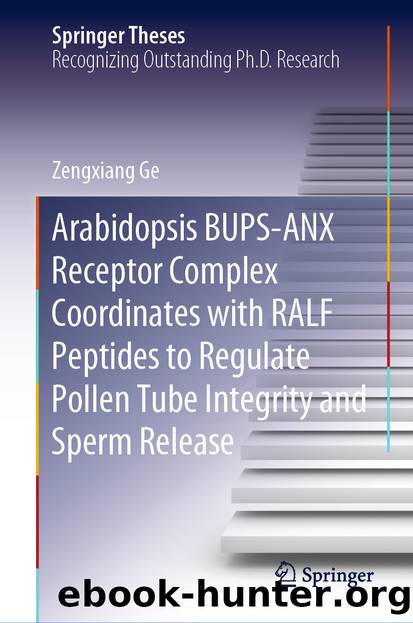Arabidopsis BUPS-ANX Receptor Complex Coordinates with RALF Peptides to Regulate Pollen Tube Integrity and Sperm Release by Zengxiang Ge

Author:Zengxiang Ge
Language: eng
Format: epub
ISBN: 9789811554919
Publisher: Springer Singapore
2.4 Discussion
In Arabidopsis, cell–cell communications between male and female tissues play a critical role in fertilization. Many membrane-localized receptor-like kinases or/and secreted peptides have been well demonstrated to function in pollen germination and pollen tube growth, pollen tube guidance, pollen tube reception, and gamete activation/fusion [6, 16, 33]. For example, FER and ANX1/2 from CrRLK1L receptor family coordinate the reception and burst of pollen tubes, since that pollen tubes show overgrowing phenotype in the ovules of fer mutant whereas anx1 anx2 pollen tubes rupture prematurely [8, 16]. There are 17 receptors in CrRLK1L family in Arabidopsis, some of which have been identified to regulate the cell expansion and cell integrity [8, 15, 20]. Here, we demonstrated that two receptors from the same family, BUPS1 and BUPS2, intensively accumulate on the plasma membrane of pollen tubes and are critical for pollen tube integrity control during the pollen tube growth.
BUPS1/2 are clustered in different clades with ANX1/2 and FER in the phylogenetic tree, and they are highly expressed in mature pollen grains and pollen tubes. After pollen germination, both BUPS1-GFP and BUPS2-GFP are mainly localized on the plasma membrane of pollen tubes. When we knocked out BUPS1 using CRISPR/Cas9 technology, we found bups1 mutant lines were male sterile and produced few seeds in the siliques. Further phenotypic analyses revealed that bups1 pollen tubes showed premature rupture both in vivo and in vitro, while no obvious defects were observed in bups2 single mutant lines. Nonetheless, bups1 bups2 showed a more severe defect in male fertility and bups1 bups2 pollen tubes burst immediately after germination in vitro. Therefore, BUPS1/2 are possibly the key membrane-localized receptors to monitor the extracellular environment and maintain the pollen tube integrity during its growth.
Among 600 receptor-like kinases in Arabidopsis, some of them have been reported to function at different stages of vegetative and reproductive growth [8, 34, 35]. For example, in Brassinosteroids (BRs) signaling pathway, BRI1 serves as a receptor to perceive BRs, whereas BAK1/SERK3 from SERK family is thought as a co-receptor of BRI1. Hetero-oligomerization between BRI1 and BAK1 is triggered by the binding of BRs. Similarly, flg22 peptide (a 22-amino acid peptide) is perceived by a membrane-localized FLS2 receptor, which results in the oligomerization between FLS2 and the co-receptor BAK1 [34–36]. Our current knowledge about the role of RLKs in reproduction is still very limited, so are the molecular mechanisms of these receptors. In this chapter, we found the expression pattern and protein subcellular localization of BUPS1/2 are similar to those of ANX1/2, and the phenotypes of bups1 bups2 resemble those of anx1 anx2 [14, 30]. Given that BUPS1/2 and ANX1/2 belong to the same family and are typical receptor-like kinases, it is reasonable to think that they might work together as a receptor complex in pollen tubes. Indeed, we further found that BUPS1/2 could directly interact with ANX1/2 through their ectodomains. This interaction might be essential for the peptide recognition and binding even though the ligand is unknown. Taken together, we propose that a BUPS–ANX heteromeric
Download
This site does not store any files on its server. We only index and link to content provided by other sites. Please contact the content providers to delete copyright contents if any and email us, we'll remove relevant links or contents immediately.
| Automotive | Engineering |
| Transportation |
Whiskies Galore by Ian Buxton(41530)
Introduction to Aircraft Design (Cambridge Aerospace Series) by John P. Fielding(32888)
Small Unmanned Fixed-wing Aircraft Design by Andrew J. Keane Andras Sobester James P. Scanlan & András Sóbester & James P. Scanlan(32573)
Craft Beer for the Homebrewer by Michael Agnew(17933)
Turbulence by E. J. Noyes(7700)
The Complete Stick Figure Physics Tutorials by Allen Sarah(7141)
Kaplan MCAT General Chemistry Review by Kaplan(6595)
The Thirst by Nesbo Jo(6436)
Bad Blood by John Carreyrou(6275)
Modelling of Convective Heat and Mass Transfer in Rotating Flows by Igor V. Shevchuk(6223)
Learning SQL by Alan Beaulieu(6035)
Weapons of Math Destruction by Cathy O'Neil(5829)
Man-made Catastrophes and Risk Information Concealment by Dmitry Chernov & Didier Sornette(5647)
Digital Minimalism by Cal Newport;(5389)
Life 3.0: Being Human in the Age of Artificial Intelligence by Tegmark Max(5184)
iGen by Jean M. Twenge(5161)
Secrets of Antigravity Propulsion: Tesla, UFOs, and Classified Aerospace Technology by Ph.D. Paul A. Laviolette(4991)
Design of Trajectory Optimization Approach for Space Maneuver Vehicle Skip Entry Problems by Runqi Chai & Al Savvaris & Antonios Tsourdos & Senchun Chai(4840)
Electronic Devices & Circuits by Jacob Millman & Christos C. Halkias(4748)
